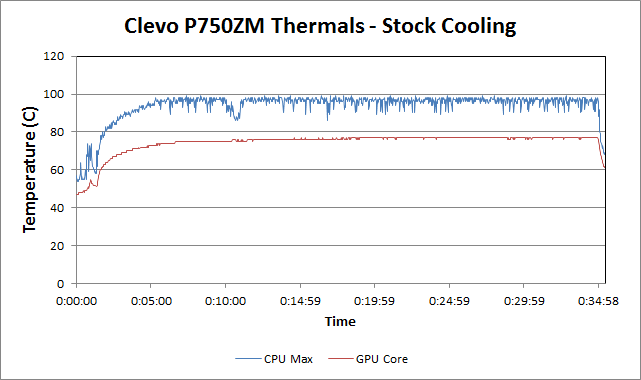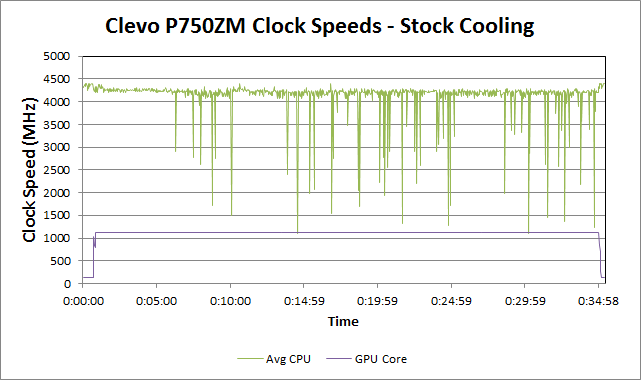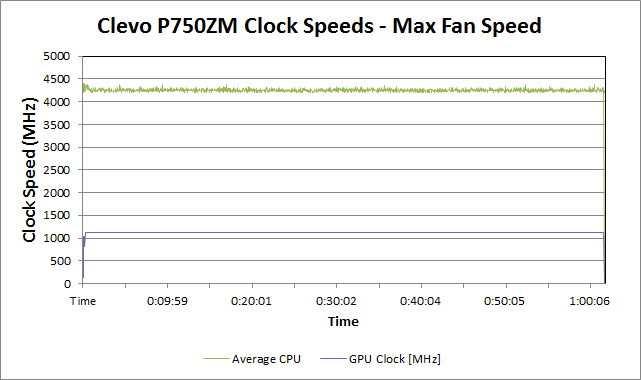Eurocom P5 Pro / Clevo P750ZM Review: True DTR
by Jarred Walton on March 10, 2015 10:00 AM ESTClevo P750ZM Thermals and Noise
Considering the high-end hardware present in the P750ZM, the thermals and noise are going to be of particular interest. Performance is great but if your notebook is screaming loud or has to routinely throttle the clock speeds any time you use it as intended then you might end up looking elsewhere. Thankfully, while the P750ZM certainly won’t qualify as a silent or exceptionally quiet laptop, it’s also not horribly loud – even at maximum fan speed. More importantly, the thermals on the GPU are really quite good…though the CPU thermals aren’t necessarily all that great.
Before we get to the results of our thermals testing, we ran the P750ZM in two modes. The default cooling is just what you’d expect: as the temperatures increase, fan speeds increase in response. There’s a second mode that is often available on gaming notebooks: a maximum fan speed mode. The idea is to keep the system as cool as possible, hopefully avoiding any throttling or variability in frame rates. This mode is activated by pressing Fn+1, and it has a nice side effect of letting us know what the absolute maximum noise level will be.
Thermals and Throttling
It’s interesting to look at the results of our thermal testing. The GTX 980M likely uses around 100W, perhaps even as much as 125W; the i7-4790K by comparison is supposed to use at most 88W. We mentioned earlier that the cooling arrangement seems to put more of an emphasis on keeping the CPU cool, with five heatpipes on the CPU and chipset compared to four heatpipes on the GPU MXM module; the above results help explain why that was likely done. With a higher thermal density (88W with a die size of 177 mm2 compared to 125W in 398 mm2), even though the GPU has more total heat to dissipate the CPU has a more difficult time staying cool.
What ends up happening is that even at stock clocks, depending on the game there will be some fluctuations in CPU clock speeds. For our testing, I used Dying Light, a recent title that tends to be one of the more demanding games when it comes to CPU and GPU workloads. Power draw for the entire notebook at the wall tends to be around 200-210W, which is up to 40W more than what I noticed with some other games. Part of the reason for the heavy CPU load is that we’ve set the draw distance to maximum, so even at maximum quality settings Dying Light can end up partially CPU bottlenecked (at least with the GTX 980M).
The net result of our thermal testing is twofold. First, the GPU generally plugs along merrily at maximum clocks with no trouble – we measured a maximum temperature of just 77C, and the fans aren’t at maximum speed for this test. On the other hand, the CPU gets into the high 90s, even hitting 99C on occasion, and it does undergo a bit of throttling to keep thermals in check. We need to be careful about that word “throttling”, however, as there are differing opinions on what that actually means. For some users, anything less than maximum Turbo Boost might be considered “throttling”, but in general we only use the term if clock speeds drop below the rated non-Turbo clock speeds (4.0GHz in this case), and more importantly it the CPU reports that any of the cores are throttling.
We used HWiNFO64 to log temperatures, clock speeds, and other system variables; one of the things HWiNFO64 reports is whether or not the CPU cores are throttling. In the case of the i7-4790K, under any sustained CPU load we do see reports of throttling on all of the cores (usually only one or two at a time). However, clock speeds are still typically above the rated 4.0GHz, with only occasional drops to lower clocks. It’s also important to note that it’s not clear if the drops are actually being triggered by the CPU throttling or if the game periodically does something that drops its demand on the CPU for a moment (e.g. loading additional assets from the storage subsystem might cause a momentary hiccup). Either way, with CPU temperatures hitting high 90s, it’s certainly at least a bit of a concern.
Interestingly, when we activate maximum cooling (Fn+1), that’s enough to fix the problem with CPU thermals and throttling. Instead of topping out in the high 90s, the maximum CPU core temperatures are now in the low 90s or upper 80s. Perhaps more importantly, the minimum CPU clocks on any core are all at 4.2GHz, where without the higher fan speeds we saw periodic drops as low as 800-1000MHz. Average CPU clocks are also up more than 100MHz over a period of an hour or so of testing. GPU performance doesn’t really change any, but temperatures also drop with a maximum of 67C now.
As far as surface temperatures go, as you’d expect the P750ZM does get a bit warm at the back near the CPU and GPU, but the plastic chassis does help to avoid conducting too much heat into the surfaces of the laptop. While the exhaust temperatures are well above 50C, most of the laptop surfaces are closer to 35C even under load, and it’s only the back inch or so around the exhausts that gets to 40C. Again, maxing out the fan speeds does reduce the exhaust and surface temperatures a decent amount if needed.
Cooling overall is good, and at high fan speed it’s very good. But what about noise levels?
System Noise
Anyone expecting a silent notebook with a desktop CPU and GTX 980M is expecting a bit much. However, that doesn’t mean the system needs to be exceptionally noisy. At idle the P750ZM tends to be pretty close to the noise floor of my house (30dB), though on occasion even in lighter workloads like surfing the web the fans will kick on for a little bit and it will go up to 35-37 dB. For gaming or CPU intensive workloads, the system gets quite a bit louder; after a few minutes the fans settled in at 41.3 dB, which isn’t too bad. Maximum fan speed on the other hand gets pretty loud, reaching nearly 48 dB.
While we’ve tested notebooks that run a lot quieter – including the MSI GT72 and ASUS G751 – they also don’t have to deal with a full voltage desktop CPU. There’s a reason this sort of processor isn’t typically used in notebooks, and even in desktops it needs fairly potent cooling to run properly. That the P750ZM mostly runs the i7-4790K without problems is good news, and as we’ve shown already performance is certainly higher than any mobile CPU we’ve tested. If the extra 10-25% boost in performance (relative to mobile parts) is helpful, the P750ZM is definitely worth a look.














74 Comments
View All Comments
Notmyusualid - Tuesday, March 10, 2015 - link
I'm a pervious owner of three Clevos, one of them being a Eurocom branded model;I believe the laptop 330W supply (as exists on the M18x) promises to *deliver* 330W, not that it only takes 330W from the wall, and then providing 85% efficiency whilst doing it... which would thereby give the machine only 280.5W. Please correct me if I'm wrong though...
Anway, I H A T E those custom Clevo 4-pin PSU connectors. With my M18x, I can actually *charge* it with any PSU that has a connector that is *physically* the same and that happens to be lying about, thereby making the machine more *portable*. You'll not see that custom connector again, outside of Clevo that is, as far as my eyes are concerned.
But I say, drop the battery altogether - and give us twice the cooling, or half the weight / chassis depth. Come on, you know it makes sense. I can count the times I've actually *needed* to use my battery on my two hands. (think check-in desk confirming a return ticket out of a country - now done [accepted by airline staff] on your smartphone.
18.4" or bust for MY money though. And I'd like that at QHD 2560 x 1440 please, nothing higher, it is just too demanding for laptop GPUs...
Build it, and they will come. Alienware dropped the 18.4" line (ball) with the recent M18. A market gap does indeed exist, but not with a Clevo keyboard, as many Clevo previous owners can attest...
Peace out.
JarredWalton - Tuesday, March 10, 2015 - link
That's true on the connector -- I find it's location and connection to be quite undesirable. I've had the cable fall out numerous times while moving the notebook around a bit. Anyway, I think the custom connector is supposed to help with delivering up to 330W -- and yes, it delivers up to 330W, so it could potentially draw as much as ~390W from the wall is my understanding. If you're wondering, under full load, even with overclocking, I don't think I've hit more than about 270W at the wall.Murloc - Tuesday, March 10, 2015 - link
Well at least 15 minutes of battery life is useful if people move the computer around without turning it off.will54 - Wednesday, March 11, 2015 - link
MSI is trying to fill it with the GT80 Titan . Though its only a 1080 pls screen and a socketed cpu, it comes with a 4710 or 4980 HQ and 980m in SLI. oh and it has a mechanical keyboard. Crazy expensive but all 18.4" notebooks with SLI were/are overpriced.SuperVeloce - Tuesday, March 10, 2015 - link
I bet those temperatures would be much better if eurocom went with mobile unlocked cpu (no IHS). But there is a thing with Intel, they probably want some crazy prices for those extreme mobile cpus (basically a 4770k without a heat spreader). I wouldn't be surprised if it costs $1kJarredWalton - Tuesday, March 10, 2015 - link
The fastest mobile part right now is the i7-4940MX:http://ark.intel.com/products/78940/Intel-Core-i7-...
While it can hit up to 4GHz with Turbo Boost, the nominal guaranteed clock speed is only 3.1GHz. It's a 57W TDP part as well, and the price is generally $1000.
The i7-4980HQ is a non-socket chip that does 2.8-4.0GHz, with the same 57W TDP, and it's priced at $623. In practice, both will likely have to clock down to 3.4-3.6GHz under sustained loads would be my guess, so the i7-4790K is still roughly 16-20% faster. And it also only costs $339. Basically it's more performance for a lower total price, but battery life and mobility take the hit.
Notmyusualid - Tuesday, March 10, 2015 - link
Agreed - I have a 3920XM (x45,42,40,38) and a 4712HQ next to me - and no matter what task / benchamark I throw at them both, the 4712HQ is only ~20% slower, or less. Despite the increase of GHz on the XM part. The XM part will eventually throttle to save itself (thanks Intel), making the XM part moot in Asia (where its hot all the time, less so in Blighty).But I can't give up this big screen. I hope not to be buried with my M18xR2, as I don't love it all that much.... :)
But despite the desktop value; order of preference goes something like this:
Screen size, GPU choices (cf / sli if poss), CPU performance, screen quality, storage options, memory options. I know I'm fussy, but it is my money...
will54 - Wednesday, March 11, 2015 - link
yeah I think a 4940mx is a $1k chip, from what I have seen they charge an extra $800 for it when you upgrade from a 4720MQ.JeffFlanagan - Tuesday, March 10, 2015 - link
Looks like a sweet machine, but I'll stick with a $400 laptop or tablet remoted into a powerful $1000 Windows desktop PC with lots of RAM and storage. This isn't great with poor LTE signal strength, but I have WiFi available most of the time.Denithor - Tuesday, March 10, 2015 - link
Sheesh, $3200 and no SSD included? Are they kidding? WTF?